While the USN's initial deployment of nuclear weapons focused on heavy airplanes to carry heavy bombs, elements within the Navy quickly saw the possibility of lighter bombs which could be carried by their existing aircraft. These weapons took several years to mature, with the first, the Mark 7, entering service in 1952. It weighed only 1,600 lbs, less than a fifth of the strategic weapons that proceeded it, and opened up the possibility of nuclear strikes by tactical aircraft. The Korean War had emphasized the fact that not all future wars would be all-out conflicts between the superpowers decided by strategic bombing, and the Navy was quick to respond.
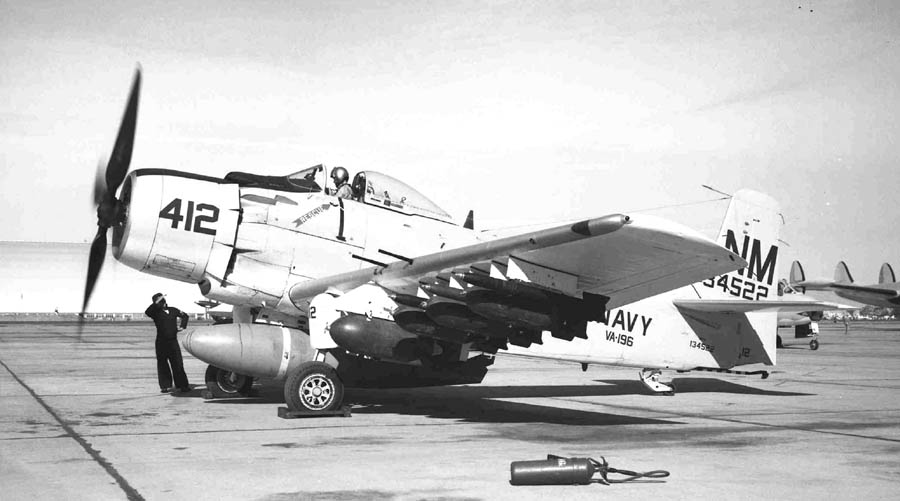
An AD-6 Skyraider with a Mk 7 bomb
Two suitable aircraft were already in service, the venerable Douglas AD Skyraider and the jet-powered McDonnell F2H Banshee. Versions of both aircraft were modified to make them suitable for nuclear weapons carriage,1 and experimental squadrons began to develop tactics for delivery. This was trickier than it sounded. Penetration would probably be made at low level, particularly with the relatively slow Skyraider, and even if higher altitudes were acceptable, both aircraft lacked the bombardiers and equipment necessary for good accuracy with level bombing.2 So the attack would also have to be at low level, which made getting the delivery aircraft clear of the blast radius rather tricky.
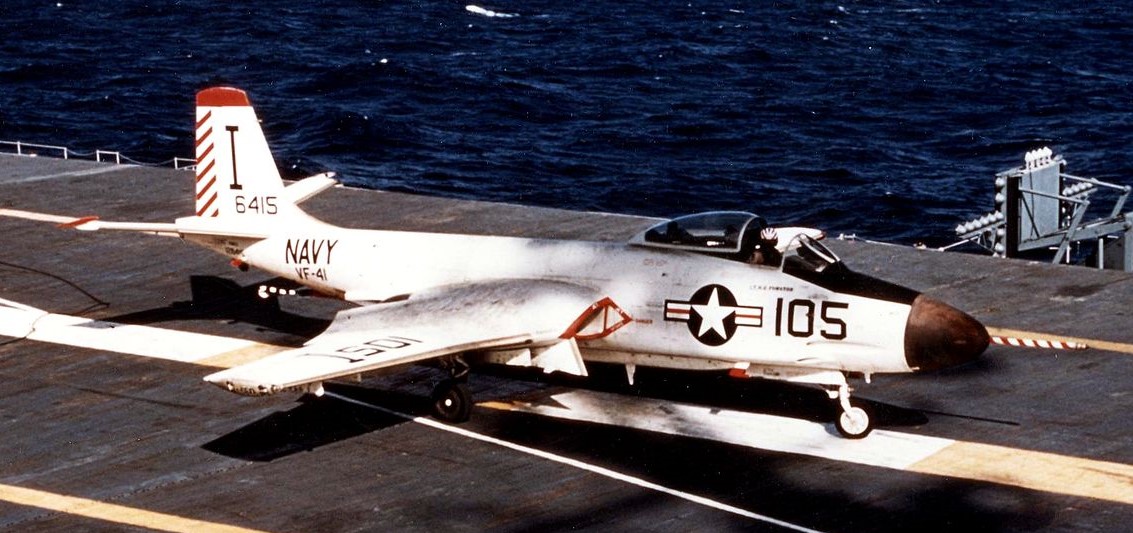
An F2H Banshee
The solution was toss bombing, a technique where the airplane essentially pulls into a loop as it nears the target, holding a specified G-load, usually 4Gs, and with a button pressed that puts the bomb release under computer control. When the weapons system decides that the time is right, which would be with the nose about 45° above the horizon for maximum range, the bomb separates and the pilot continues to pull up. At the top of the loop, the airplane, now pointed away from the target, rolls upright and dives for safety. The biggest problem with this approach was finding an appropriate landmark to start the loop on. The release angle could be varied to widen the targeteer's options, but in some cases, there simply were no good choices. Another technique was developed to deal with these, "over-the-shoulder bombing".
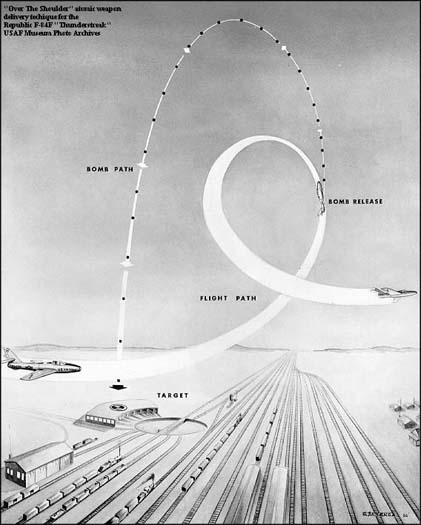
An over-the-shoulder bombing attack
In this case, the pilot would use the target itself as the landmark to start his loop, and the bomb would be released after the airplane had passed through vertical, with the nose about 110° above the horizon, tossing it back towards the target. The plane would either escape much as it did in conventional toss bombing or complete the loop and fly off along the same course he originally was flying. While he was doing this, the nuclear weapon climbed to 10,000' or so above the target, then came back down, giving the pilot 45 seconds or so to get clear. The procedure quickly gained the nickname of the "idiot loop", and had the major disadvantage of requiring the plane to overfly the target, but it gave better accuracy than toss bombing, and became a mainstay of nuclear delivery from tactical aircraft for much of the 1950s.
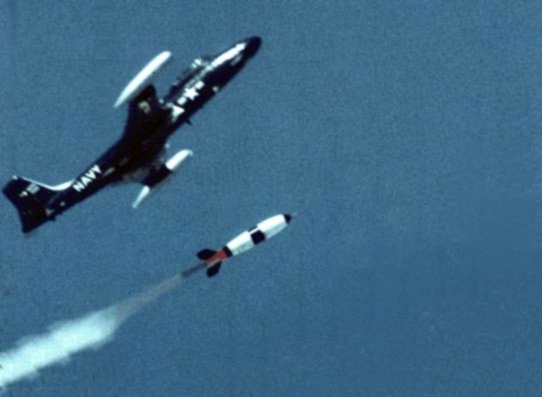
A BOAR is fired from the F2H
For some heavily-defended targets, however, greater standoff was required. To deal with these, the Navy developed the Bombardment Aircraft Rocket or BOAR, essentially a Mk 7 bomb with a big rocket attached. There was no guidance, but it would give a standoff of up to 7.5 miles, allowing the attacking aircraft to escape. Despite its simplicity, it survived in service from 1956 to 1963, and was heavily used on the AD Skyraider, which otherwise might have had trouble penetrating defenses. BOAR was the only standoff nuclear weapon employed by naval aircraft, although a successor, Hopi, underwent flight tests before being cancelled.
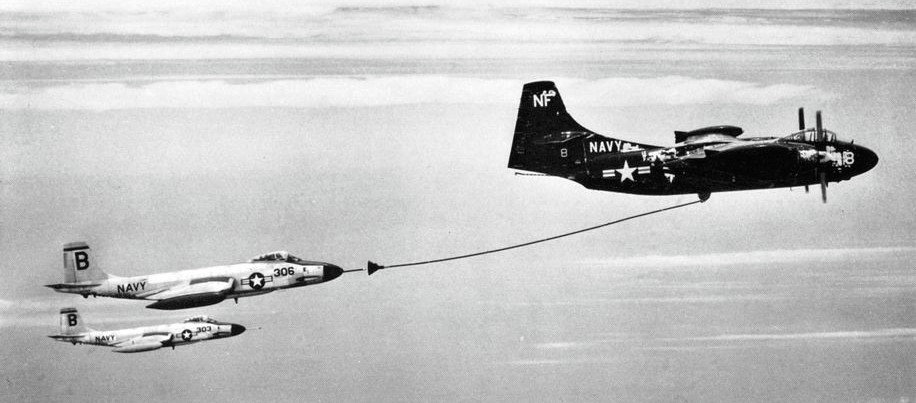
F2Hs refuel from an AJ Savage tanker
The Navy also worked hard on getting to the target, testing the ability of pilots to fly extended missions at extremely low altitudes, often less than 100' above the surrounding terrain. Soon, doctrines were developed and some squadrons began intensive training. One notable test was an attempt by several Banshees, flying from a carrier anchored east of Cuba, to attack a target on Lake Erie in the face of everything NORAD could throw at them. With the help of aerial tankers, the jets crossed the coast of Georgia and made it all the way to the target undetected, then proceeded to use the high-altitude capability of their airplanes to evade the USAF interceptors chasing them.3 This kind of low-level flight remained a mainstay of the light attack community until it disappeared in the 1990s.
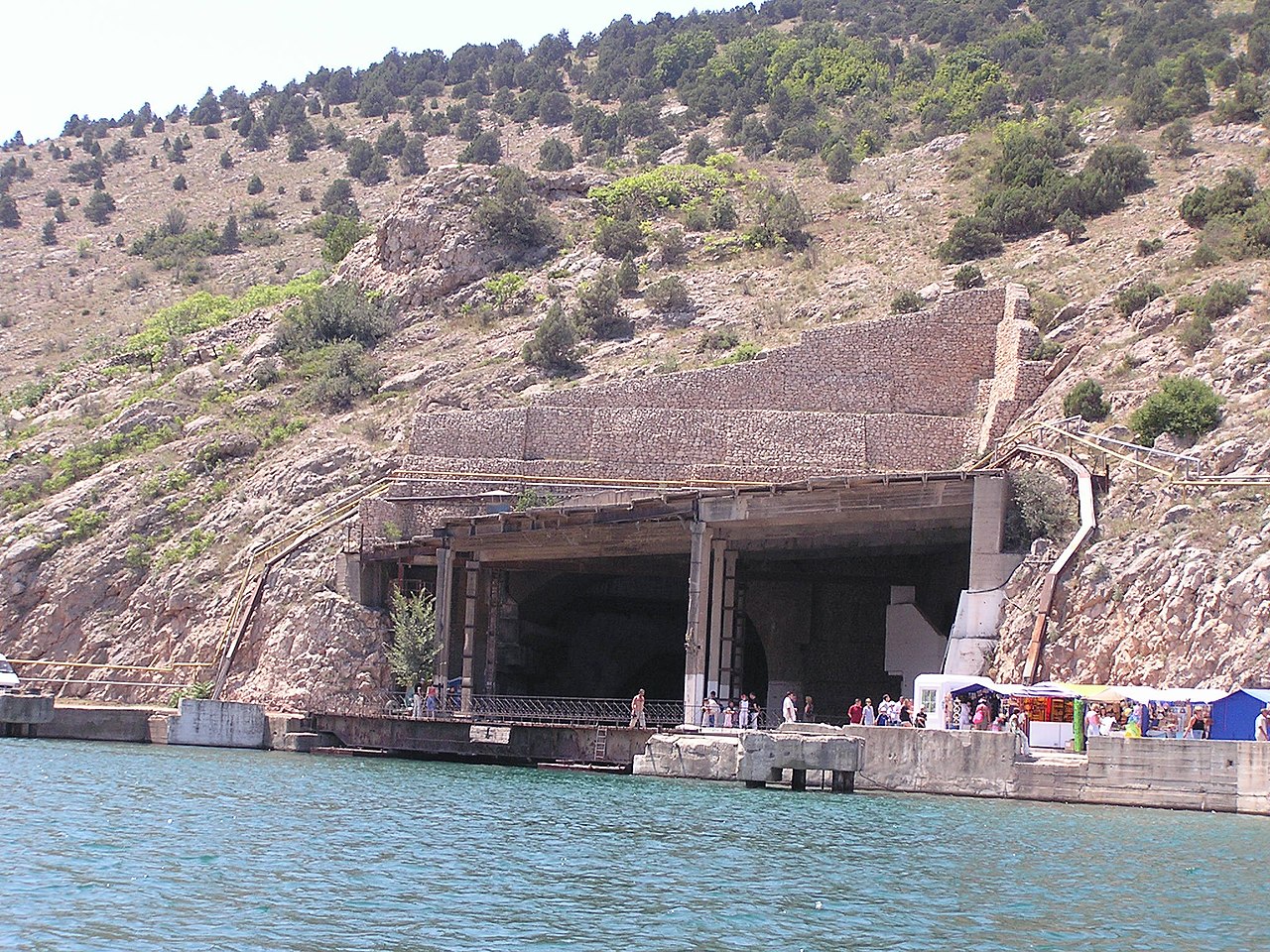
The entrance to the Soviet submarine base at Balaklava, a facility of the type targeted by the Navy
Throughout the 1950s, one of the Navy's leading missions was to protect the North Atlantic from the Soviet submarine force in the event of war. Hunting the submarines in the open ocean was possible, but studies repeatedly showed it would take enormous forces, far beyond what was fiscally feasible. Instead, they turned to a strategy called "attack at source", destroying the bases with their carriers. During WWII, the Germans had built massive fortified submarine pens that had proved virtually impervious to air attack, and the Soviets appeared to be doing the same. The proposed solution was nuclear bombs, but the existing bombs of the day were not particularly suitable to the task. The problem was that an airburst, while tremendously destructive to unhardened targets like cities, is easy to protect against, and because the Air Force was only interested in destroying cities, all of the early bombs were only fuzed for airburst.
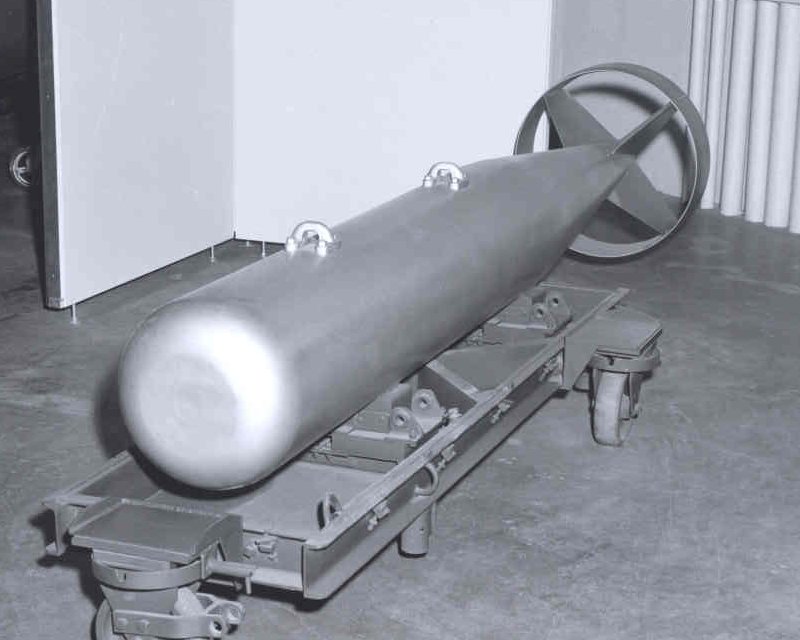
A Mk 8 bomb
The Navy proposed that a penetrating bomb be developed, which could be dropped on a target, pierce earth or concrete, and then be set off by a time fuze once the attacking aircraft was safely away. This was opposed by the Air Force and most of the atomic establishment for two reasons. First, the heated interservice politics of the day made any form of cooperation unlikely. Second, the implosion designs of the day were too fragile to survive impact and penetration, and so the new weapon would need to use the gun-type design pioneered by Little Boy, which required enough Uranium to produce three implosion bombs. Despite these obstacles, the Navy perservered and produced the Mk 8, handling development of most of the non-nuclear components itself. Only 40 of these weapons were produced,4 and the plan if they were used was to drop them into the water off the entrance of the submarine pen, presumably to add massive contamination to the physical destruction wrought by the bomb.
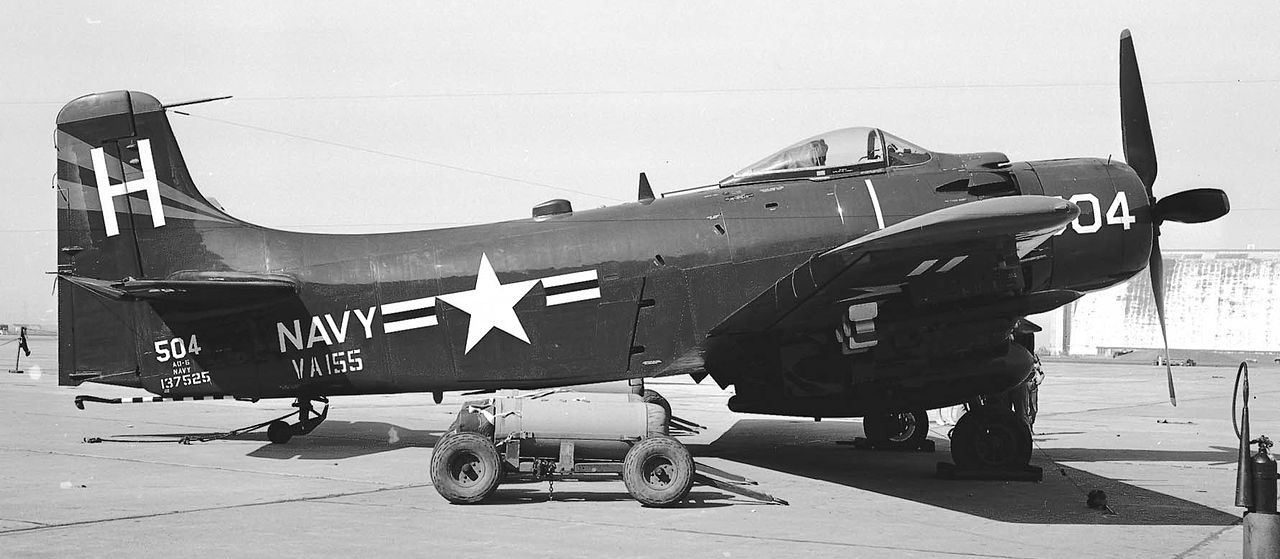
An AD Skyraider
As a result of all of this effort, by the mid-50s, the Navy had built a viable carrier-based nuclear strike force, with both light and heavy aircraft capable of making a major contribution in the event of nuclear war with the Soviet Union. But while the heavy attack force was soon to fade away, the light attack aircraft would soldier on through the end of the Cold War. We'll continue their story next time.
1 The Banshee was a particularly tricky plane to fit the 30" diameter Mk 7 on, even though the bomb had a folding fin to improve deck clearance. Special sleeves had to be fitted to landing gear to fully extend them and keep the Mk 7 from dragging. Also, fuel on takeoff was limited due to the weight imbalance, and there was no way to land with the bomb onboard. ⇑
2 Nuclear weapons, particularly back then, are less powerful than you might expect. A Mark 7 would only destroy concrete buildings within half a mile or so of its burst. ⇑
3 Due primarily to an emphasis on top speed, the early-50s USAF jet fighters tended to have relatively poor performance at very high altitude. ⇑

Comments
I've read about the "idiot's loop" in a few other articles, but none of them actually explained why you need to fly a loop over the target instead of just tossing the bomb from a safe distance - because you need a landmark to line up the toss. So kudos for a good explanation.
Modern deep penetration bombs have returned to the old conventional design used by the British Tall Boys and Grand Slams, which is how they eventually took out the German u-boat pens, without need for nukes.
@beleester
Thanks. It was interesting to dig through all this and figure out what was going on.
@DoctorPat
First, even the earthquake bombs weren't all that effective at killing U-boat pens. Second, a Grand Slam weighs somewhat more than the heaviest light attack aircraft in service at the time, IIRC. The Air Force might have been able to kill the pens with a couple of wings of B-36s, but they had better things to do with those planes, and the Navy could fit a Mk 8 aboard their carriers and kill the pens themselves.
I think that should be Lake Erie, no?
No, they attacked Ireland. Avoided NORAD's defenses very effectively.
Fixed.
I'm curious about this undetected attack across most of the eastern US. How did a Banshee even have the range? What was ths mission called? Anything you wanna tell would be awesome.
I'm curious about this undetected attack across most of the eastern US. How did a Banshee even have the range? What was ths mission called? Anything you wanna tell would be awesome.
I'm curious about this undetected attack across most of the eastern US. How did a Banshee even have the range? What was ths mission called? Anything you wanna tell would be awesome.
Not sure about the mission details, but the range issue was apparently solved with tankers. Probably not quite a Black Buck level of silliness, but maybe more than just a single refuelling.
My reference (the book Nuclear Weapons and Aircraft Carriers) only brings up one refueling, about 150 miles off the coast, which they crossed near Savannah, Georgia.
It's about 650 miles from Savannah to Cleveland, so call it a 1600 mile round trip from the refuelling point, plus getting back to the carrier. That sounds manageable, though flying low and carrying a bomb would reduce your range somewhat.
Just fooling around with nothing better to do and stumbled on this website. Checked my logbook and found the top pictured AD-6 with my old Squadron's name on it (VA-196) was apparently newly arrived in the squadron just as I was detached. I show a grand total of 3.8 hours in it starting with first flight 4/29/59.
Discussion re: various delivery type of special weapons interesting. We trained extensively in the 1/2 cuban eight delivery and did some in a wingover type delivery (I suspect with the BOAR in mind). Also never found anywhere was a delivery we practiced that was called (as I recall) a "high dive". Absolute ridiculous delivery technique requiring an AD carrying the weight of a weapon to a high altitude; then rolling into a 70 degree dive (with the bottom dive brake wired shut (weapon was in the way of the brake) and a pullout (as I recall) by 10,000 feet. Accuracy none. Probable escape--none. But a/c would never have been able to climb to altitude before being shot down anyhow. (Memories now 66 years old)
Always cool to hear from someone who did the stuff I'm describing. And man, that high dive sounds both terrifying and pointless. The only plausible case I can see for it would be in cases where you have to worry about ground fire but not fighters, and while that can't be completely ruled out, it seems more sensible to find someone who isn't an AD to deliver the bomb in those cases.